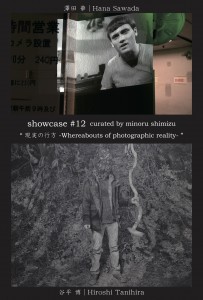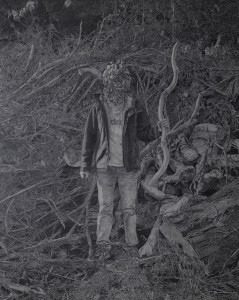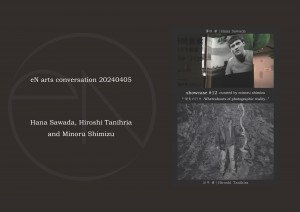→日本語
showcase #12 “Whereabouts of photographic reality”
curated by minoru shimizu
Hana Sawada | Hiroshi Tanihira
2024.04.12(fri.)— 05.12(sun.)
open on fri., sat., & sun. 12:00-18:00
appointments are available on weekdays
.
From April 12th, eN arts will be presenting “Showcase #12,” a group exhibition specializing in photography and video curated by Professor Minoru Shimizu. As its title suggests, this exhibition provides a true “showcase” for contemporary young photographers and video artists. With the first Showcase having been presented in 2012, this year’s exhibition marks its 12th consecutive year. This year Mr. Shimizu has selected two rising artists to present their works at “Showcase#12” exhibition: Hana Sawada and Hiroshi Tanihira.
This year, as well, eN arts will be participating in KYOTOGRAPHIE2024, the month-long international photography festival in Kyoto, as a KG+ for Collectors this year. Please refer to https://kgplus.kyotographie.jp for details. The theme of KYOTOGRAPHIE2024 is “‘SOURCE’ – The source is the beginning, the beginning, and the origin of all things.”
At showcase #12, we invite you to come and explore the fate of reality in photographic and video works…Is photography the source or reality the source?
eN arts looks forward to your visit.
Naomi Rowe | eN arts
→Click here to see previous “showcase” curated by minoru shimizu.
.
showcase #12 curated by Minoru Shimizu
Whereabouts of photographic reality
The 12th Showcase 2024 features Hiroshi Tanihira (b.1982, first appearance) whose surprisingly detailed and dense graphite drawings have attracted attention, and Hana Sawada (b.1990, second appearance since 2018) who, since her Canon New Century of Photography Award 2017(specially mentioned by Sandra Phillips), has been active in a number of exhibitions.
In Tanihira’s works a shermanictic figure is drawn in finest hard-edge lines with extreme richness of details. Since its emergence photography has visualized the invisible one after another, such as photographs of farthest nature and universe, as scientific or sport photographs capturing the one-thousandth instant, or those of ectoplasms and ghosts. In the end we could say, that the “reality” we know, be it visible or invisible, has come to consist of nothing but ordinary photographs. Reality is photographic! You would not call it “real” unless I draw it in exactly photographic style … this was/is an ironical core of the Superrealism which firstly emerged in the 1970’s and is still found in popular media such as YouTube.
Contrary to this, Tanihira’s pencil pursues something un-photographable, something that must lie beyond the photographic “reality”. Therefore, the essence of his works, the beautiful gray shine expressed in extremely fine, almost engraved lines, cannot be photographed. Please do not fail to look at the originals.
Now, a photograph is always a photograph of “something”, that is, the referent of photography, which has been regarded as something real outside of photography. The objects of Sawada’s works are digital images found in the internet. These are all digitally scanned, so to speak vacuum-packed images. Did/Does such ”thing” really exist, though? Here the artist tries to trace them back to their referents, which have once existed in reality, as she cuts the packed images open, uses digital methods and reconstructs the flattened images to three-dimensional objects.
It is not that Sawada would believe in “something”’ real existence. In her playful manipulations and humorous deployments of images, she rather expresses a kind of reality of recent digital images, which have totally broken with reality that has ever been.
April, 2024. Minoru Shimizu
.
Hana Sawada
I am awfully drawn to trifling things that are largely overlooked. For example, something small that happens to be included in a photograph. A sound, that sounds like speech, that I didn’t catch. My own shape, reflected in the monitor when I watch a movie. Or what “to understand” has in common with “to assume.” At those moments, I stop and look closely; that is where my work begins.
Images and words are surprisingly vague and slippery. Meaning is formed by the imagination, and accepted, lead there by the knowledge and experience of the person who encountered that trifling thing.
Imagination is like putty, natural, convenient, and easy to use to connect and fill in bumps and holes. Even if, for example, the filling in is rather crude and forced, one does not recognize that.
Arbitrarily connecting images and words, with imagination between them, seems perfectly natural behavior, but briefly stopping that movement or going too far with it makes their connections momentarily clear. When that happens, the distortions and gaps, the slips and deviations, that existed in the images and words are exposed. At the same time, we devote our consciousness to our imagination, to fill in those flaws. (For example, even if imagination immediately catches up and becomes familiar.)
.
Hiroshi Tanihira
The person depicted in the work is myself dressed as a fictional character I call Bush whacker, and the scenery in the background is the mountains and the sea within a few kilometers radius of where I live. To explain what a Bush whacker is, the term was coined to refer to a person who whacks President George W. Bush, who had started the Iraq War the year before, in 2004, when the original video work for this film was created. Although the word Bush whacker may suggest an anti-war message, it is not so much a social theme as it is a one, and was born out of the disquieting atmosphere felt by everyone at the time. The clothes of the Bush whacker are the same as the everyday clothes of the so-called working class, with the hope that it is the people who will change power and society.Allegorical motifs sometimes limit the meaning of a work, but I description them because I needed them to understand the work.
On the other hand, Bush whacker’s masks are also influenced by Japanese culture, especially by visiting deity, such as the use of sakaki in Shinto rituals. And it is interesting to note that there are events similar to in visiting deity various parts of the world. As the international situation continues to worsen, the basis of the production is an exploration of how to remain Japanese in the world and how one can relate to the world oneself.
・
eN arts conversation 20240405 Hana Sawada, Hiroshi Tanihira
and Minoru Shimizu
.
.
-WORKS-
-INSTALLATION VIEW-


-201x300.jpeg)

